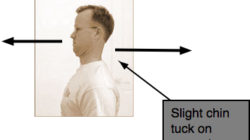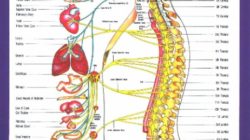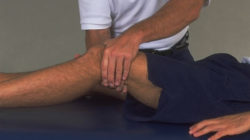Thoracic Spine Pain
The MID-BACK
THORACIC SPINE PAIN is rarely serious but frequently can be very irritating. Metastases from known cancers of the lungs and breast should be kept in mind, but they are very much the exception.
There are twelve thoracic vertebrae, each attached via three joints to a rib on each side (thus six in total), which in turn is joined to the breastbone. It stretches from the base of the neck to the bottom of the ribcage.

This means that each thoracic vertebra has 8 joints associated with them: two with the bones above and below, and six with the ribs. A great many joints (12 x 8 = 96) in total, each with supporting ligaments and muscles, making it a complex and sometimes painful area.
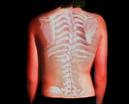
The midback is far more stable than the neck and lumbar spine because of the stabilising effect of the rib cage. Each vertebra is attached by a rib to the breastbone (sternum) thus giving the whole chest a certain rigidity. This makes it far less liable to the serious disc injuries associated with the neck ARM PAIN and LOWER BACK PAIN.
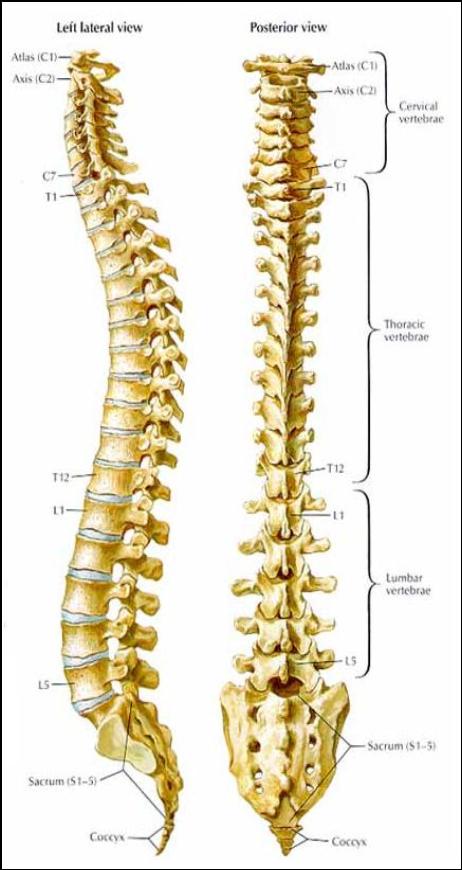
Seen from the side, the thoracic spine has a natural curve called a kyphosis. This provides the spine with a certain amount of ‘give’ when for example jumping from a height onto the ground. A straight spine would tend to give too much axial compression, and fracture the bones.
CAUSES OF OSTEOPOROSIS
However, the kyphosis can increase for pathological reasons causing thoracic spine pain. The most common is the so-called kyphotic (bent) spine of the elderly. It is usually associated with osteoporosis and anterior wedging of the vertebrae, as seen in this MRI of a spine with an anterior compression fracture. For more on the causes of osteoporosis,

SCHEUERMANNS DISEASE
Another fairly common condition,Scheuermanns disease causes an increased kyphosis affecting teenagers. It causes pain usually between the shoulder blades (and less commonly in the low back) and is the cause of the poor posture and slumped shoulders seen in about 5% of teenagers.
What is quite often seen in the practice, in young to middleaged adults, is a Scheuermann-like thoracic deep achey pain. It has many of the hallmarks of Scheurermanns – a stiff and rigid thoracic spine, an increased kyphosis, sometimes a scoliosis, loss of disc space with mild degenerative changes, but without the typical bone changes associated with Scheuermanns. I call it a light form of Scheuermanns, as it has so many similar clinical features, and is managed in much the same way.
If these joints are not brought into movement, then the hyaline cartilage, starved of nutrients and oxygen, degenerates and on X-ray it just looks like typical osteoarthritis. A stitch in time … or, in our context, a Chiropractic adjustment in time, saves nine barrow loads of Thoracic Spine pain!
HYALINE CARTILAGE, the second most important page at this site.
TIETZES SYNDROME
The attachments of the ribs firstly to the spine via the
- costo-spinal joints, RIB PAIN TREATMENT,
- and secondly, in front, to the breastbone
- COSTOSTERNAL CHEST PAIN
Both of these joints, at the back between the shoulder blades, and in front at the breastbone are common cause of thoracic spine pain seen in every chiropractic clinic. Sometimes, if it irritates the intercostal nerve, it may follow the rib to the sternum. This latter condition, sometimes called TIETZES SYNDROME, is quite often, if it affects the ribs on the left, confused with a HEART ATTACK because the pain is directly over the heart, and may be increased wih exercise which stresses the heart (as in angina), but also the rib-sternum joint when breathing deeply.
What may catch any chiropractor out, in it’s early stages (and presumably your medical doctor too) is an attack of shingles. This is a viral condition causing a nerve-type pain that follows the rib. After a few days the vesicles appear … his/her face will be red! But I’ve never had a case of shingles that I’ve treated inadvertently, that has gone on to become a chronic nerve pain, as can happen.

THORACIC OUTLET SYNDROME
The upper thoracic spine is a unique area for two reasons. Firstly, it is an area of change, where the highly flexible neck meets the very rigid mid-back. The C6-T2 area is thus very prone to injury and tingling or pain in the arm. THORACIC OUTLET SYNDROME …
The second reason is the presence of the shoulderblades or scapula(e). These large flat bones are the anchor points for many of the large shoulder muscles, SHOULDER ANATOMY … and are themselves firmly anchored to the thoracic spine.
As you can appreciate, there are a great many muscles, ligaments, joints and bones in the mid-back. The injuries associated with them are not usually serious, but are the cause of many niggling, aching pains between the shoulder blades.

Just as in the rest of the spine, careful examination and management of thoracic spine pain is what gives chiropractic a very definite edge in the treatment of this part of your spine. Exercise and rehabilitation is essential if you are to prevent your pain becoming chronic, and you have no desire to visit your chiropractic twice a week for the rest of your life. Exercise or ache. Take your pick!

